|
|
Wednesday, March 20, 2013 |
Perfect competition: Key concepts
| Assumptions: |
- identical (homogeneous) products
(=> there is only price competition)
- many "small" sellers (=>firms are "price takers")
- easy entry and exit (=> LR profits = 0)
- perfect information (=> no miscalculations)
|
A. Equilibrium in the short
run
1. Choosing output
Firms try to maximize profits (p)
= TR - TC
TC =
TC(Q) => MC = DTC/DQ
TR =
TR(Q) => MR = DTR/DQ
TR(Q) = P(Q).Q. For a PC
firm, P = a constant => MR = P
2-step process to choosing profit-maximizing output
(Q*):
Step 1: Expand production as long as MR
> MC (the upward-sloping
portion of MC).
Step 2: If profits are < 0, check to be sure that TR > TVC
(=> P > AVC). If not, shut down.
The shutdown option:
Q=0 => TR = 0, TC = TFC, p = -TFC
=> better to operate at Q* if
p > -TFC =>
TR - TC >
-TFC =>
TR > TC - TFC =>
TR > TVC =>
TR/Q* > TVC/Q* =>
P > AVC at Q*
2. Calculating and
illustrating profits
| |
p |
= |
TR |
- |
TC |
| |
|
= |
P.Q* |
- |
ATC.Q* |
| |
|
= |
Q* |
. |
(P - ATC) |
| |
|
= a rectangle: |
Base |
. |
Height |
B.
equilibrium in the long run
Profits > 0 => entry until
profits = 0 again
Profits < 0 =>exit until profits = 0 again
Firm supply decisions under perfect competition
| Suppose you have a costume firm with the cost
structure given in the table below. You are a perfectly competitive firm, so you can sell
as many Halloween costumes as you want at the going market price. |
| |
|
|
| Part 1: Suppose that the price =
$13, and the following table summarizes your revenue and cost situation: |
|
| (1) |
(2) |
(3) |
(4) |
(5) |
(6) |
(7) |
(8) |
(9) |
(10) |
| Q |
P |
TR |
TC |
TVC |
TFC |
Profit |
MR |
MC |
MRvsMC (>,<,=) |
| 0 |
13 |
0 |
13 |
0 |
13 |
-13 |
--- |
--- |
--- |
| 1 |
13 |
13 |
22 |
9 |
13 |
-9 |
13 |
9 |
> |
| 2 |
13 |
26 |
27 |
14 |
13 |
-1 |
13 |
5 |
> |
| 3 |
13 |
39 |
33 |
20 |
13 |
+6 |
13 |
6 |
> |
| 4 |
13 |
52 |
40 |
27 |
13 |
+12 |
13 |
7 |
> |
| 5 |
13 |
65 |
50 |
37 |
13 |
+15 |
13 |
10 |
> |
| 6 |
13 |
78 |
63 |
50 |
13 |
+15 |
13 |
13 |
= |
| 7 |
13 |
91 |
80 |
67 |
13 |
+11 |
13 |
17 |
< |
|
|
How much output should the firm produce to
maximize profits? Q* = ________ |
| |
|
|
| Part 2: Marginal analysis helps determine
the firm's profit-maximizing output (Q*) for any possible market prices: |
|
2.1: Expand production as long as MR
> MC
(the upward-sloping portion of MC).
2.2: If profits are < 0, check to be sure that TR > TVC (=> P
> AVC). If
not, shut down. |
| |
|
|
|
| (1) |
(2) |
(3) |
(4) |
(5) |
(6) |
(7) |
(8) |
(9) |
| P=MR |
Q* |
TR |
TC |
Profit |
TVC |
AVC |
MC |
PvsAVC |
| $17 |
7 |
119 |
80 |
+39 |
67 |
9.57 |
17 |
> |
| 13 |
6 |
78 |
63 |
+15 |
50 |
8.33 |
13 |
> |
| 10 |
5 |
50 |
50 |
0 |
37 |
7.40 |
10 |
> |
| 8 |
4? |
32 |
40 |
-8 |
27 |
6.75 |
7 |
> |
| 7 |
4? |
28 |
40 |
-12 |
27 |
6.75 |
7 |
> |
| 6 |
3? |
18 |
33 |
-15 |
20 |
6.67 |
6 |
< |
|
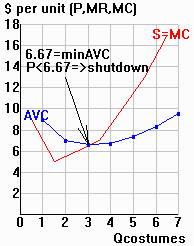 |
|
Key lesson: The firm's supply curve = its
upward-sloping MC curve above its minimum AVC
(for price < minimum AVC, Qs = 0). |
|
|
|
Output and shutdown decisions
Palm Desert resort hotel
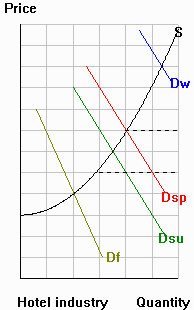 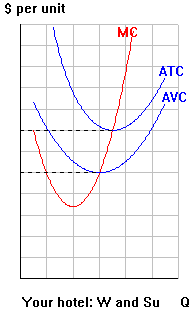 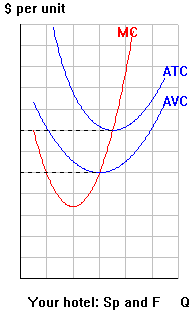 |
| |
| Suppose you own a resort hotel in the perfectly competitive
tourist market of Palm Desert. The lefthand panel above depicts the hotel industry in Palm
Desert for each of the four seasons: W=winter, Sp=spring, Su=summer, and F=fall. |
| |
| Your task is to illustrate your profit-loss situation for
each season in the two righthand panels above, which depict your hotel's cost curves,
(assumed to be the same for each season). Use the center panel for the winter and summer
seasons, and the the righthand panel for the spring and fall seasons. |
| |
| For each season: |
|
1. Draw your marginal revenue curve. |
|
2. Indicate your most profitable output level if you
operate. |
|
3. Indicate the size of your profits or losses if you
operate. |
| |
| Complete the following table: |
| Season |
Profits (>,<,=) 0? |
Operate or shutdown? |
| Winter |
|
|
| Spring |
|
|
| Summer |
|
|
| Fall |
|
|
|
| |
Perfect competition: Review exercise
| 1. |
Suppose the market price is $10. Use
"Q1" to label the firm's profit-maximizing output in the diagram to the right.
How did you decide?
|
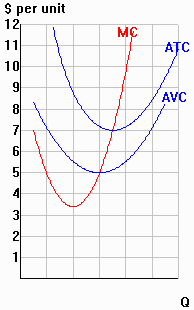 |
| 2. |
Suppose the market price is $4. Use
"Q2" to label the firm's profit-maximizing output if the firm continues to
operate. |
| 3. |
Indicate in the diagram the firm's profits/losses
at the output level you chose for question 2. |
| 4. |
Should the firm operate or shut down if the price
is $4? How did you decide?
|
| |
|
|
|




